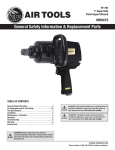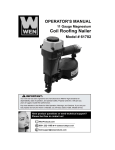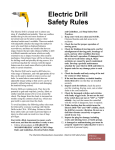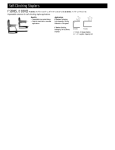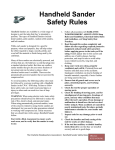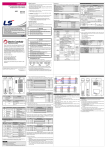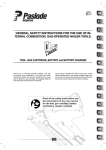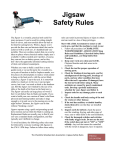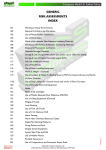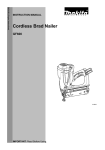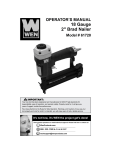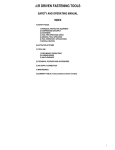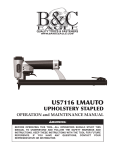Download Nailer and Stapler Safety
Transcript
Nailer and Stapler Safety Rules Nailers and Staplers are available in a number of styles using a variety of technologies to propel the fasteners. Probably the most common types are the pneumatic nail guns and staplers. These are powered by compressed air which is usually provided by an electrically powered compressor. Other technologies used to propel fasteners can be found in cordless electric nailers and fuel cell nailers like those from Paslode. For specific safety guidelines for non-pneumatic nailers and staplers, refer to the user manual for those tools. This document will cover general guidelines for safe use of nailers and staplers, but safety practices specific to pneumatically powered models will receive more detailed focus, as that is what we currently have in the shop. Detailed safety practices that are specific to cordless electric and fuel cell nailers and staplers can be found in the manuals for those tools, but aren’t covered in this document at this time. Some nailers and staplers have an operating mode know as contact trip (or contact trigger). In this mode, as long as the operator keeps the trigger depressed, the gun fires a fastener each time the nose of the gun is depressed. This type of use is referred to as bump, or bounce, firing. The other mode of operation is sequential trigger. In this mode the nose of the gun must be depressed prior to depressing the trigger. This mode is safer because a sequence of actions must take place for a fastener to be fired. This makes the chances of accidentally firing a fastener much lower than what they are with contact trip. Start with a Risk Assessment to ensure a safe work area, and that the tool is ready to use: 1. Follow all procedures in CHARLOTTE WOODWORKERS’ ASSOCIATION Shop Rules and Guidelines, Electrical Safety Rules and Guidelines, and Shop Safety Best Practices. 2. Keep your work area clean and well lit. Cluttered benches and dark areas invite accidents. 3. Do not point the tool at co-workers or yourself at any time. These tools are called “guns” for a reason and can be very dangerous, especially if misused. 4. AVOID HORSEPLAY!!! 5. Porter-Cable includes this warning in their instruction manual for pneumatic nailers: “When using any pneumatic tool, all safety precautions, as outlined below, should be followed to avoid the risk of death or serious injury. Read and understand all instructions before operating the tool”. 6. NEVER assume the magazine is empty. Don’t fire the nailer or stapler at anything you don’t want to have a fastener embedded in. 7. Don’t fire the gun into free space. The path of these fasteners unpredictable and they can cause serious injury including putting out eyes, and they have to land somewhere. 8. Inspect the tool carefully before use. Do not operate the tool if any part of the tool, trigger, or contact trip is inoperable, disconnected, altered, or not working properly. 9. Inspect the tool to verify that the trigger and contact trip move freely. Check that screws and fasteners are not loose and if they are, tighten them properly. Check for binding of all other moving parts, and for misalignment of moving parts, breakage of parts, and any other condition that may affect the tool’s operation. If damaged, have the tool serviced before using it. Many accidents are caused by poorly maintained tools. Develop a periodic maintenance schedule for your nailers and staplers then follow it. The Charlotte Woodworkers Association | Nailer and Stapler Safety Rules Effective 5/19/14 DP/WJ 10. Check the handle and body casing of the tool for cracks or other damage. 11. Inspect the pressure connector plug for defects. If the connector plug is loose or appears damaged in any way, have it serviced before using the gun. 12. Inspect the air hose and its connectors carefully to ensure that they are in good condition and appear to be working properly. Air hoses should be maintained with the same care that you would direct to the air tool itself. Hoses and their connectors are a critical part of the pneumatic fastening system, and if they malfunction they also have the potential to cause personal injury. 13. A tool that’s leaking air, damaged, missing parts or malfunctioning in any way must be properly repaired or replaced prior to use to avoid risk of personal injury. 14. Keep the area around where you’ll be working clear of people and debris that could impair your traction or footing to avoid potential slips and falls. 15. Keep nailers and staplers dry, clean and free from external oil and grease. 16. Some nail guns and pneumatic staplers require a small amount of the proper type of oil to be dropped into the air fitting to keep the tool working properly, others are oil-free. The exact requirements vary by specific model of gun, so consult the User Manual to determine the requirements for the gun you’re using. Follow the User Manual directions to avoid damage to the gun you’re using. 17. Never carry the gun with your finger on the trigger. Carrying guns with your finger on the trigger significantly increases the chance of accidental firing. 18. Many models of fastener guns have tool-free adjustments, but tools are needed to adjust others. If you use a tool to work on the nailer or stapler you’re using, remove the tool and store it properly before attaching the tool to the air supply. This will eliminate the possibility of injury or damage from the tool remaining attached to the gun while the gun is in use. 19. Use safety equipment. Always wear eye protection. Non-skid safety shoes, hard hat, and hearing protection must be used when situations call for them. 20. Actuating a nail gun or stapler may result in flying debris, collation material, or dust which could harm the operator’s eyes. The operator and other people in the work area MUST wear eye protection. Safety glasses (ANSI Z87.1) and (CAN/CSA Z94.3) with side shields or a face shield must be worn. Everyday eyeglasses are only made of impact resistant glass, they aren’t safety glasses. If you’re not wearing actual safety glasses, wearing safety goggles over your regular glasses can provide the protection you need. 21. Hearing protection should always be worn. 22. Use the appropriate dust mask or respirator in dusty work conditions. Nailers and staplers make only a minimal amount of dust, but the exhaust that comes out of them each time a fastener is fired can stir up any dust in the area where you’re working. 23. Give the work your undivided attention. Operational Safety Rules: 1. Approach your work in the Shop & while using nailers or stapler with a safe attitude! 2. Read the manual of operating/safety instructions (User’s Manual) that came with the nailer or stapler. If you can’t find it and if the Shop Foreman can’t help you find it, someone can download a copy of the manual from the internet. This manual should tell you how to load the magazine, what types of fasteners are supported, where the controls for the tool are and how they’re supposed to work. It will also explain the necessary steps for firing fasteners, and what safety mechanisms the tool incorporates to prevent accidental firing. 3. If you don’t know how to use the nailer or stapler properly for the work you want to do, get instruction on how to use it correctly BEFORE beginning. 4. Keep bystanders, children, and visitors away from the work area while operating any tool, air powered or otherwise. Having anybody not involved in the fastening operation in the immediate area can create distractions that can cause you to lose focus and make mistakes. The Charlotte Woodworkers Association | Nailer and Stapler Safety Rules Effective 5/19/14 DP/WJ 5. 6. 7. 8. 9. 10. 11. 12. When nailers or staplers are not in use, they should be secured in a safe place, out of the reach of children. Stay alert, watch what you are doing and use common sense when operating nailers and staplers. Do not use tools while tired or under the influence of drugs, alcohol, or medication. A moment of inattention while operating these tools may result in serious personal injury or even death. Keep your face and body parts away from the back of the tool cap when working in restricted areas. Sudden recoil can result in impact to the body, especially when nailing into hard or dense material. To minimize the risk from flying dust and debris adjust the guns exhaust port so that it is pointed in a safe direction. Use only clean, dry, regulated air. Moisture from a compressor can damage the internal parts of most air guns. Regulate air pressure to the proper level for the gun you’re using. Use air pressure that’s within the range shown on the nameplate of the tool. For further restrictions on maximum compressor operating pressure and absolute maximum pressure that can be applied to the gun, consult the tool’s instruction manual. Only use air hose that is rated for a maximum working pressure of at least 150 psi or 150% of the maximum system pressure, whichever is greater. This means that if your compressor has a maximum pressure of 120 psi, you’d need to use air hose rated for at least 120 psi x 1.5 = 180 psi. Do not use bottled gases to power pneumatic nailers or staplers. Bottled compressed gases such as oxygen, carbon dioxide, nitrogen, hydrogen, propane, acetylene or air are not for use with pneumatic tools. Never use combustible gases or any other reactive gas as a power source for these tools. There is a danger of explosion and/or serious personal injury may result. Do not use a nail gun or pneumatic stapler in the presence of flammable dust, gases or fumes. The tool may produce a spark that could ignite gases or flammable dust causing a fire. Driving a fastener into another 13. 14. 15. 16. 17. 18. 19. 20. 21. fastener may also cause a spark which could ignite flammable materials. Never carry a pneumatic tool by the air hose. Never yank the air hose to disconnect it from an air tool or the compressor. Use the connectors properly. If you don’t know how, contact the Shop Foreman and they will help you find someone who can show you how these connectors work. Use couplings that relieve all pressure from the tool when air hose is disconnected from the tool. Use hose connectors that shut off the air supply from the compressor when the tool is disconnected. Disconnect the tool from the air supply (or remove the battery pack in cordless tools) when the tool is not in use. Always disconnect the tool from the air supply and remove the fasteners from magazine before leaving the area or passing the tool to another operator. Do not carry the tool to another work area in which changing location involves the use of scaffoldings, stairs, ladders, and the like, with air supply connected. Disconnect the air supply before making adjustments, removing the magazine, performing maintenance or clearing jammed fasteners. On some models with contact trip (bump fire), if the contact trip is adjusted when the tool is connected to the air supply and nails are loaded, accidental discharge may occur. Connect the tool to the air supply before loading the fasteners to prevent a fastener from being fired when the air hose is connected. Tool driving mechanisms may cycle when the tool is connected to the air supply. Be sure you understand the proper steps to follow when loading fasteners into the nailer or stapler you’re using before proceeding. If you have any doubts, consult the User Manual for guidance. If you can’t find the User Manual, see the Shop Foreman for assistance and they will help you find someone who can demonstrate the procedure or locate the manual either in the shop or on the internet. The Charlotte Woodworkers Association | Nailer and Stapler Safety Rules Effective 5/19/14 DP/WJ 22. Never load fasteners with the trigger or safety depressed. This will prevent unintentional firing of a fastener. 23. Choosing the proper triggering method is important on guns that support options. Check the manual for triggering options. 24. Bump or Contact Action Trigger When using the bump action trigger, be careful of unintentional double fires resulting from tool recoil. Unwanted fasteners may be driven if the contact trip is allowed to accidentally re-contact the work surface. To Avoid Double Fires: Maintain firm control of the tool. Use moderate force to press the contact trip against the work surface. Allow the tool to recoil fully after each fastener is fired. Using sequential action triggering will eliminate double fires. When in the contact actuation mode, be aware that inaccurate placement of tool can result in misdirected discharge of a fastener. 25. Sequential Action Trigger When using sequential action trigger, do not actuate the tool unless the tool is placed firmly against the workpiece. 26. Do not remove, tamper with, or otherwise cause the tool, trigger, or contact trip mechanism to become inoperable. Do not tape or tie the trigger or contact trip in the on position. Do not remove the spring from the contact trip. Failure to follow the procedures outlined in this section could result in uncontrolled discharge. 27. Always assume that the tool contains fasteners, even if you’ve taken the fasteners out of the magazine. There have been cases where people were injured when an “empty” nail gun fired a fastener that remained in the gun after the magazine had been “emptied”. 28. Never “Dry Fire” a nailer or stapler. Doing so can damage the driving mechanism. Some models of nailers and staplers have a lock-out mechanism that prevents trigger activation once the fastener level drops to a certain level, but others do not, so be sensitive regarding how many fasteners remain in the gun’s magazine. 29. Depth Adjustment 30. 31. 32. 33. 34. 35. 36. To reduce the risk of serious injury from accidental fastener discharge when attempting to adjust fastener depth, ALWAYS Lock the trigger OFF if your gun supports trigger lock out. Disconnect the air supply. Avoid contact with the trigger during all adjustments. Remove your finger from the trigger when you’re not driving fasteners. Never carry the tool with your finger on trigger. Using the trigger lock-out will help prevent accidental firing. Make sure the air hose is free of obstructions and snags. Entangled or snarled hoses can cause you to lose your balance or footing which may result in injury. Use these tools ONLY for their intended purpose. Do not fire fasteners into open air, concrete, stone, extremely hard woods, knots or any material too hard for the fastener to penetrate. Don’t use the bodies of these tools or their top caps as hammers. If you disregard these guidelines, the discharged fasteners may follow an unexpected path and cause injury to you or to someone in the area. Always keep your fingers (and all other parts of your body) clear of the contact trip to prevent injury from accidental discharge of a fastener. In general this is a good habit to develop, even if the gun you’re using has a sequential trigger. Do not drive fasteners near the edge of a workpiece. The workpiece may split causing the fastener to ricochet, injuring you or a coworker. Be aware that the fastener may follow the grain of the wood, causing it to protrude unexpectedly from the side of the workpiece. Drive fasteners perpendicular to the grain to reduce the risk of injury. Do not drive fasteners onto the heads of other fasteners or with the tool at too steep of an angle. Injury from strong recoil or ricocheted fasteners may result. Do not drive nails or staples blindly into walls, floors or other work areas. Driving fasteners into live electrical wires, plumbing, or other types of obstructions can result in injury and/or property damage. The Charlotte Woodworkers Association | Nailer and Stapler Safety Rules Effective 5/19/14 DP/WJ 37. Keep air hoses away from heat, oil and sharp edges. When using pneumatic fastening guns, make sure you place the air hose in such a way that you won’t nail or staple through it by accident. 38. Do not use air hoses to lower or raise tools. 39. Make sure that the trigger isn’t depressed before plugging the air hose onto the tool (or installing a battery pack on electric nailers or staplers). Some air power fastening tools have a trigger “lock-out” or “lock-off” and you can use these features to ensure that the trigger isn’t depressed, accidentally or otherwise, while connecting the tool. 40. Be aware of material thickness and fastener length when using the nailer or stapler. A fastener protruding through the material could cause injury. Make sure that your fasteners aren’t going out of the material where they could present a danger to yourself or others. 41. Use these tools with extreme care at pressures near the high end of the tool’s operating range. Fasteners can be driven completely through thin or very soft material when the pressure at the gun becomes high. Set the pressure at the compressor so that the fasteners are set into the material at an acceptable depth and aren’t pushed completely through. 42. Do not reach under the material being fastened. Never support material to be joined with any part of your body (or an assistant’s body). If a fastener is longer than you anticipated or if it’s driven deeper than normal, the hand that’s under the material being fastened could be injured if part of a fastener is driven into it. Caution all assistants to avoid putting any body part in the areas where the fasteners may be traveling and warn them not to reach under the material being secured. 43. Do not overreach. Keep proper footing and balance at all times. Proper footing and balance enables better control of the tool in unexpected situations. 44. Make sure the fastener selected is the proper type and length for the material you’re planning to join. 45. Use only fasteners that are compatible with your model of nailer or stapler. Fasteners are 46. 47. 48. 49. 50. available in a huge variety of packaging and some are designed for guns with magazines that feed at an angle while other feed straight into the gun. Some even come in rolls that are fed through a rotary magazine. Attempting to use fasteners that aren’t designed for your tool can lead to damage to the tool which in some cases is expensive to repair. Secure material being joined properly for most reliable results. While you can hold material down to a proper support surface, don’t hold unsupported material to be joined it in your free hand or against your body. Holding the work by hand or against your body is dangerous and unstable; taking that approach may lead to loss of control and could lead to serious injury. Hold the workpiece with clamps when necessary to ensure that you and any others can all stay out of harm’s way. Be sure that the workpiece is properly secured before pressing the gun’s nosepiece against the material to be fastened. If work isn’t properly secured, guns with contact trip may discharge causing the workpiece to shift unexpectedly. Make sure all supports, clamps and holding devices are clear of the area where fasteners could travel before continuing. Keep your hands and body parts, and those of any coworkers or assistants, clear of the immediate area where you’re driving fasteners. Remember that once a fastener is fired, its path may not be a perfectly straight line. It could be deflected by wild grain, a knot, or a piece of unseen hardware that’s in the material being joined. Allow adequate margin of safety so that if the fastener travels in an unexpected direction, and perhaps a bit further than expected, you and your helpers will be clear of its ultimate path. Grip the gun firmly to maintain control while allowing the tool to recoil away from the work surface when a fastener is driven. In contact trip mode (bump firing) if the nose of the gun is allowed to re-contact the work surface before the trigger is released an additional (unwanted) fastener will be fired. Some dust created by power sanding, sawing, and grinding, drilling, and other construction The Charlotte Woodworkers Association | Nailer and Stapler Safety Rules Effective 5/19/14 DP/WJ 51. 52. 53. 54. activities contains chemicals known to cause cancer, birth defects or other reproductive harm. Some examples of these chemicals are: • Lead from lead-based paints • Crystalline silica from bricks, cement and other masonry materials • Arsenic and chromium from chemically treated lumber Your risk from these exposures varies, depending on how often you do this type of work. To reduce your exposure to these chemicals: work in a well ventilated area, and work with approved safety equipment, such as those dust masks that are specially designed to filter out microscopic particles. Maintain tools with care. Keep tools clean. Properly maintained tools are less likely to have problems while they’re in use. DO NOT alter or modify the nail gun or stapler in any way! Any alteration or modification of the tool is considered misuse and may result in a dangerous condition. When finished using the nailer or stapler for the day, unplug the air supply (or remove the battery pack in cordless tools), remove and store fasteners, and store the tool and all its accessories properly, out of the reach of children and other untrained persons. Tools are dangerous in the hands of untrained users. Before storing the nailer or stapler for the day, clean it if necessary so that it will be ready when the next person wants to use it. Coil the air hose properly (if it has one), and then store it properly. 2. When servicing a tool, use only approved replacement parts. Follow instructions in the Maintenance section of the manual applicable to that make and model of tool. Use of unauthorized parts or failure to follow the correct maintenance instructions may create a risk injury. Certain cleaning agents such as gasoline, carbon tetrachloride, ammonia, etc. may damage plastic parts. Before using chemical cleaning agents on a tool check the manual for that make and model of tool for approved cleansers and cleaning procedures. Maintenance and Service 1. Tool service must be performed only by qualified repair personnel. Service or maintenance performed by unqualified personnel could result in a risk of injury. If a tool belonging to CWA or our host organization needs maintenance, contact the Shop Foreman. If the tool is still under warranty, they will make arrangements for the service to be done under the warranty. If the manufacturer’s warranty has expired, they will ensure that the tool is repaired by properly qualified repair personnel. The Charlotte Woodworkers Association | Nailer and Stapler Safety Rules Effective 5/19/14 DP/WJ






